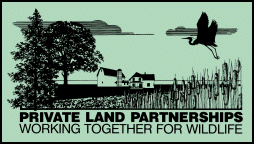 |
|
HOMES FOR
WILDLIFE II
PLANS
|
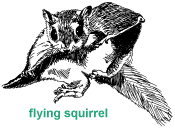 It is essential to provide wildlife with the habitat components of cover, food, space, and water. Providing homes will
help provide cover and will aid in attracting a variety of wildlife to your backyard. This
chapter furnishes plans for the previous Homes for
Wildlife chapter. Most of the plans here are for birds, but there are also
structures for squirrels and rabbits. The plans for the bluebird house and bat house can be found in their respective chapters
in the Species Management section. All
birdhouses are made from 3¼4" wood; do not use metal. Also, to prevent rain from
seeping into the cracks enclose the floor with the sides instead of nailing the sides to
the top of the floor. Attach birdhouses to a support post, building, or tree. All nest
boxes should be predator-proofed to
prevent threats from climbing predators such as housecats, raccoons, and squirrels. In
most cases this can be done by placing a metal cone or a sheet of tin on poles or around
trees underneath the nest box. It is essential to provide wildlife with the habitat components of cover, food, space, and water. Providing homes will
help provide cover and will aid in attracting a variety of wildlife to your backyard. This
chapter furnishes plans for the previous Homes for
Wildlife chapter. Most of the plans here are for birds, but there are also
structures for squirrels and rabbits. The plans for the bluebird house and bat house can be found in their respective chapters
in the Species Management section. All
birdhouses are made from 3¼4" wood; do not use metal. Also, to prevent rain from
seeping into the cracks enclose the floor with the sides instead of nailing the sides to
the top of the floor. Attach birdhouses to a support post, building, or tree. All nest
boxes should be predator-proofed to
prevent threats from climbing predators such as housecats, raccoons, and squirrels. In
most cases this can be done by placing a metal cone or a sheet of tin on poles or around
trees underneath the nest box.
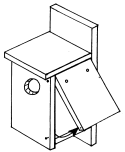 |
House Wren, Black-capped Chickadee,
Nuthatches, Flying Squirrel, Deer Mouse,
White-footed Mouse Nest Box
|
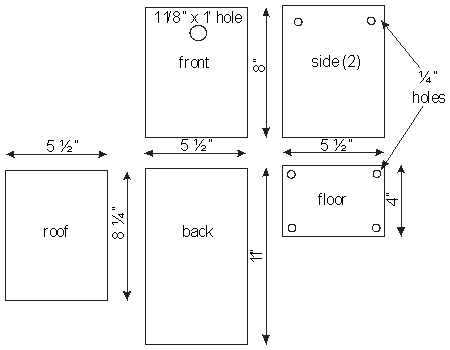 |
| Two "pivot" nails, one tope front and one top
back, allow side to swing out for cleaning. Use one nail or screw at bottom to hold side
closed. Nuthatches and flying squirrels require an entrance hole that is 1 1/4" in
diameter. Also, remember that a hold larger than 1 1/8" in diameter will admit house
sparrows. |
|
Northern Flicker
|
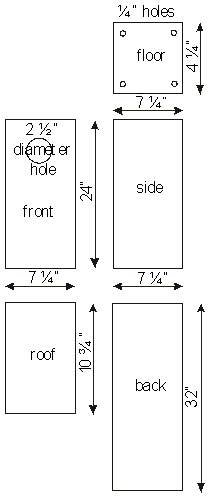 |
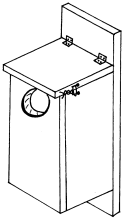 |
| Hinge roof for cleaning, and use a wire to keep the box shut.
Place body of box 5 inches from the top of the back. Fill the box to the top with sawdust. |
|
Wood Duck
|
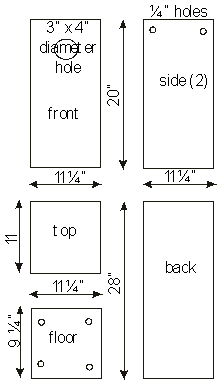 |
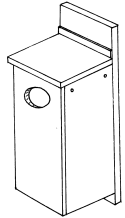 |
| Hinge roof for cleaning, and use a wire to keep the box shut. |
|
American Robin, Barn
Swallow, and
Eastern Phoebe Nest Shelf
|
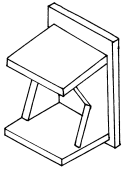 |
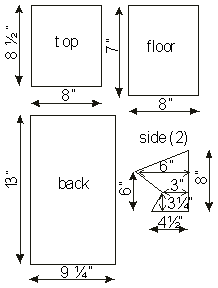 |
| Place body of shelf 2 inches from top of back. |
|
American Kestrel, Gray
Squirrel, Red Squirrel,
and Fox Squirrel
|
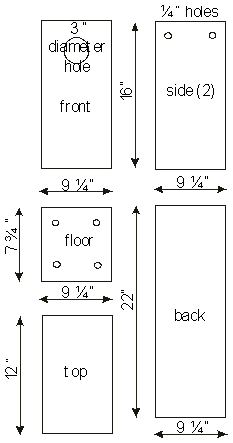 |
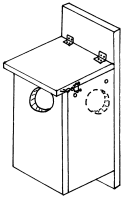 |
| Hinge roof for cleaning, and use a wire to keep the box shut.
Place 3 inches of sawdust in bottom of box. For a squirrel box, place entrance on side of
box instead of front. |
|
Mourning Dove and Mallard Nest Basket
|
 |
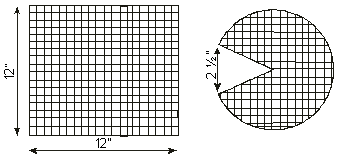 |
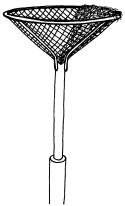 |
| Cut with tin snips to form a circle. Cut out a pie shape, and wire edges together to
form a cone. Place onto tree limb with wire. A mallard basket can be made in the same way
using 36 inch by 36 inch wire mesh, and placing on 2 foot 2 inch pipe above water.
Vegetation for nesting is placed in the mallard basket and secured with soft wire. |
|
Squirrel Tire Den
|
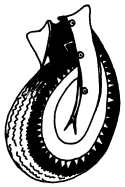 F.
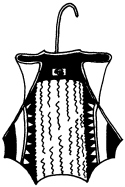
|
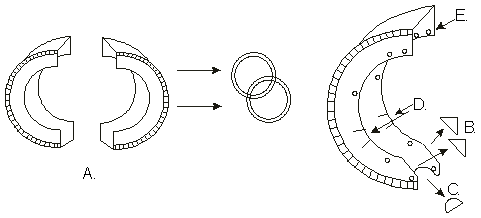 |
| Old tires can be reused to construct a squirrel den. Use a regular, non-steel belted,
tire. a) remove the bead from both sides of the tire, and cut the tire in half. B) cut a 3
inch triangle from each corner of the bottom of the tire. C) in the same end, cut a 3 inch
diameter semicircle (this is the entrance hole). D) cut 3 inch flaps in sidewalls about
1/3 distance up from the bottom of the tire. E) Punch holes into the sidewalls as shown.
F) Fold the short end of the tire into the long end, and secure with roofing nails and
washers. Hang with heavy wire or metal rod. |
|
Rabbit Den
|
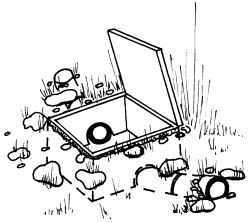 |
| Dimensions of the burrow are not critical. A bottom is not necessary, as
it will sit on the ground. Use durable lumber for the box, and bury it at ground level.
Two semicircles should be cut on opposite ends at the bottom of the box. The tile should
fit snugly into these holes. Bury the tiles at about 45 degree angle from the surface of
the ground to the bottom of the box. |
|
For more information available on the World Wide Web about "Homes for
Wildlife," please see our Resource Links.
Last Revised: May 5, 2000
|

